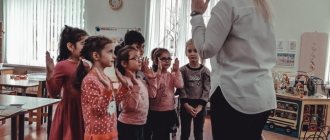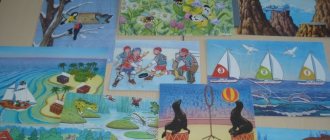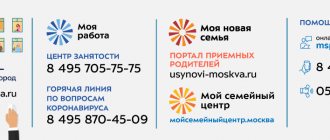Project activities in the work of a speech therapist teacher
Marina Morozova
Project activities in the work of a speech therapist teacher
presentation on the topic:
«Project activities in the work of a speech therapist teacher»
Teacher-speech therapist Morozova M. V. MBDOU d/s No. 16 Kropotkin
Our modern children live in a world of computers and the Internet, cell phones. Children learn to acquire knowledge by isolating it from the information flow, and learn to communicate through trial and error. A child’s ability to maintain interest in learning about the world around him, the desire to learn and discover new things becomes the foundation in the development of the child’s personality and the key to successful learning at school.
design occupies a special place in preschool education . The essence of design in education is the organization of the educational process in which children acquire knowledge and skills, experience in creative activity , and an emotional and value-based attitude to reality in the process of planning and performing gradually more complex practical tasks.
To increase the effectiveness of speech therapy work in the educational process, along with speech correction, I widely use research work . Project activities are aimed at the formation and development of children's communication skills, preparation skills for educational activities , proper time management, planning and self-control. Speech therapy training for preschool children with general speech underdevelopment is carried out through the interaction of an adult and a child. This cooperation helps children learn to independently search for ways and means of solving their own problems. A child with a speech disorder ceases to be an object of pedagogical influence and becomes an active participant in creative activities , the purpose of which is to activate his own resources in the process of learning and development.
As practice shows, in recent years the number of children with speech difficulties has been growing steadily. Standardized methods of correctional work with children with speech disorders do not always give the expected result. In this regard, the search for effective forms and methods becomes relevant, the need to include search activities , which require the use of knowledge and skills in a new situation for them, to solve new problems. Analyzing various forms of correctional work with children with speech disorders, we looked for those that would speed up the process of production, automation of impaired sounds, and, in general, the development of all components of speech, cognitive processes, communication skills, and came to the conclusion about modernizing joint children's projects into practice work of a speech therapist teacher .
PROJECT DESIGN
Title page: at the top – the name of the institution; middle – the name of the project in capital letters , full name of the author; below – city, year.
Project motto or aphorism
Page 3: — type of project (by composition, by deadline, by type)
; — participants;
-authors of the project (if many)
.
Page 4: project :
1. Problem (clear, concise sentence of what the problem is)
.
The formulation of the problem usually “follows”
out of relevance.
2. Relevance (if the project is for a period of more than 6 months)
3.Goal: Formation….
4. Tasks (three
: educational, developmental, educational)
From page 5:
the project implementation stages
1.) Preparatory (preparing something, collecting something)
Collecting information about, questioning, selecting audio or video materials, etc. 2.) Main (conducting itself)
Educational areas (indicate which are involved, GCD
(indicate what excursions, outdoor games, etc.)
for the implementation
of the project ). Working with parents : joint activities (for example, producing creative works , joint trips, etc.).
3.)Final:
-1-2 final events (holiday, matinee, entertainment, etc.)
;
-project product ;
- Expected results.
Diagnostic studies (at the beginning and at the end, if a long-term project )
.
List of references (if the project is long-term )
.
Application:
Project portfolio : GCD notes, scripts, any material.
Photo supplements: photographs of project .
Purpose of the design method :
Creating conditions that reveal the creative and intellectual potential of preschool children, focused on dialogical interaction between children, parents and teachers.
Projects are classified:
1. By composition of participants
2. By target setting
3. By topic
4. According to the deadlines for implementation.
Types of Target Installation Projects
Research - creative (children experiment, and then the results are presented in the form of newspapers, dramatization, children's design).
Role-playing (with elements of creative games, when children take on the role of characters in a fairy tale and solve the problems in their own way).
Information-practice-oriented (children collect information and implement it, focusing on social interests - group design, stained glass, etc.)
Creative – (formatting the results in the form of a children’s party, children’s design, for example: “Space Week”
).
Mixed project :
• interdisciplinary in subject-content area;
• creative mono-projects - carried out within the framework of a narrow problem, one section of training.
By implementation time
Short term
( projects lasting from 1 day to a week)
;
Medium term
( projects from 1 week to 1 month)
;
Long-term
( projects lasting 1 month or more)
.
Logomag
In preschool age, children should have the experience of creating their own ideas and implementing their projects. Children can conceive and implement research and creative projects.
The most important educational guideline, in accordance with the Federal State Educational Standard, is the development of children's independence (initiative, independence and activity). To do this, teachers are recommended to:
-show respect for the child’s personality and develop a democratic style of interaction with him,
- create conditions for the child to accept responsibility and show empathy towards children and adults;
-discuss important life issues with children, stimulate the manifestation of the child’s position;
-discuss with parents the goals towards which the activities of preschool teachers are aimed and include family members in joint interaction to achieve these goals.
The content of project activities is planned in accordance with the age of the child.
Senior group
Project activities are included in the field of “Cognitive Development” and involve
in older age:
-creating conditions for children to implement projects of three types:
*research
*creative (individual)
-organization of project presentations;
-forming in children an idea of the authorship of the project;
In the pre-school group:
— creating conditions for children to implement projects of three types:
*research
*creative
-develop the ability to pay attention to analyzing the effectiveness of information sources;
-encourage discussion of the project among peers;
-promote creative activities of an individual and group nature;
- when working on regulatory projects, encourage discussion of situations and negative consequences;
-help children symbolically display a situation, experience its main meanings and express them in figurative form.
Work on projects, including drawing up a reasonable action plan, which is formed and refined throughout the entire period, goes through several stages
:
- goal setting;
-search for forms of project implementation;
-development of the content of the entire educational process based on the topic of the project;
-organization of a developing cognitive subject environment;
- determination of directions of search and practical activities;
-organization of creative research and practical activities together with teachers, parents and children;
-work on parts of the project and its correction;
-collective implementation of the project and its demonstration.
The project method creates conditions for the manifestation in children of such qualities as initiative, cheerfulness, curiosity, the desire to learn new things and show their individuality, that is, it ensures the successful socialization of the child and the formation of his personality.
The interests of children act as material for achieving the goals of educational work - developing the child’s abilities and initiative, mastering cultural means available for preschool age. Thanks to the use of the design method in joint activities, children are taught the ability to intelligently and creatively relate to reality, be proactive and make decisions independently.
Since 2014, I continued the implementation of project activities in the conditions of the speech center of preschool educational institution No. 33. The activities of a speech therapist teacher at a speech center differ from work in compensatory groups.
The main forms of organizing work with children with speech disorders at the speech center are individual lessons lasting 15-20 minutes. and subgroup – lasting 20-35 minutes. (in accordance with the specialist’s training schedule). Group work is not expected.
The main tasks of the speech therapy service are:
— identification of pupils with speech development disorders;
— implementation of the necessary correction of sound pronunciation disorders in preschool children;
— formation and development of phonemic hearing in children with speech impairments;
— nurturing children’s desire to overcome speech deficiencies and maintain emotional well-being in their adaptive environment;
— realizing the opportunity to integrate education and training in a regular group with receiving specialized assistance in speech development;
— interaction with teachers of educational institutions and parents on the formation of children’s speech development.
Having studied and analyzed a large number of sources of information, it was concluded that little attention is paid to the use of project activities in a log center. Speech therapist teachers use mainly thematic projects at the speech center, citing the lack of group classes with lexical content.
The result of the first information and analytical stage was the creation of a card index on the topic of self-education.
Having considered the general grounds for using design in preschool practice, the project “Such necessary sound toys” is planned,
the main goal of which was
to develop self-control skills of spoken speech sounds in children.
In order to support children's initiative, children were asked to independently come up with the name of the sound artist and his image. The name of the sound player had to contain the sound being automated. It turned out that most children associate the image of a sound boy with gnomes from a fairy-tale sound land, but the children also suggested other images: the girl Raya, the tiger cub Igrunok, the car Grunya, the little penguin Skipper and others.
The most important condition for ensuring the holistic development of a child’s personality is the development of constructive interaction with the family.
Project activities create conditions for the formation of responsible relationships with the families of pupils and the development of parents' competence in matters of correcting speech underdevelopment in children, and also ensure the right of parents to respect and understanding, to participate in the life of the kindergarten.
Questioning
parents were aimed at studying the attitude of parents to the organization of correctional work at the speech center of a preschool educational institution, identifying difficulties in consolidating speech therapy material, as well as finding ways to create a more effective speech correction process.
Parents were informed about the system of working on sound pronunciation (information in the speech therapist’s corner, a workshop on working on sound pronunciation, design of the “Favorite Sounds” stand, individual conversations),
conditions were created for solving the assigned tasks, encouraging parents and children for participation in project activities and attentive attention to the individual self-expression of children (awarding diplomas for participation in project activities).
Particularly interesting was this form of presentation by children of their projects.
, as independent conduct of classes with their Sound students in a subgroup of children, united by the similarity of sound pronunciation disorders. The children copied the speech therapist teacher, trying to guide the journey clearly and emotionally, and strictly followed the pronunciation of the automated sounds. In subsequent lessons, the children independently chose who they would play with today. The children’s statements about the importance of project activities were also interesting.
Thus, the project “Such necessary sounds” contributed not only to the automation of delivered sounds, but also to the improvement of all aspects of a child’s speech, the formation of children’s initiative and independence, the development of partnerships and the ability to work “in a team”, master the methods of collective mental activity, and unite the efforts of teachers , parents and children in order to implement the project.
Bibliography
1. From birth to school. Approximate general educational program for preschool education / edited by N.E. Veraksa, T.S. Komarova, M.A. Vasilyeva. - M.: Mozaika-Sintez, 2014. - 368 p.
2. “On the organization of the work of the speech therapy center of a general education institution” / letter dated December 14, 2000. No. 2
3.O.I Davydova. Projects in working with families.-Sfera, M.-2012
Article:
In connection with updating the content of preschool education, the need to adjust the methods of program implementation has become especially acute.
To increase the efficiency of work, it is necessary to find new approaches and forms of teaching and nurturing a child’s versatile personality, involving all full participants in the pedagogical process: specialists, educators, parents, children. Only in joint activities between a child and an adult, where the child acts as a partner, is it possible to achieve high results. Based on many years of experience, we have come to the conclusion that it is necessary to develop correctional and developmental projects that will ensure the effective work of the speech therapist, specialists and educators, taking into account the interests of the child, and will also increase motivation for further acquisition of knowledge and skills. This method or form of cognition of the surrounding world gives the child the opportunity, using various types of activities (cognitive-research, play, creative, etc.) to enrich his life experience. As the child develops, he can gradually identify the problem, comprehend the goal, and choose solutions. By nurturing independence, the desire to know oneself and the world around him, the child gets a chance to be realized in life, the opportunity to achieve his goal.
The music director, physical development director, speech therapist, and educators participated in the development of the group’s program. They decided to structure the work in the form of lexical-thematic projects of different durations: short-term, long-term, etc., depending on the lexical topic and volume of work.
Within the framework of the project, various types of activities are successfully integrated: appliqué, drawing, modeling, cognitive, speech development, etc. The project on the lexical topic is designed mainly for one week, during which all participants (specialists, speech therapist, educators, parents, children) comprehensively learn and explore this topic. The project method allows all participants in continuous educational activities to actively participate in the research work, develop communication skills, develop the ability to see a problem and find ways to solve it, and establish partnerships.
As a result, the project achieved more effective development indicators in various areas:
— correction and development of all components of children’s speech (sound pronunciation, lexical and grammatical structure, syllable structure, analysis and synthesis, coherent speech, prosody);
— development of productive activities (application, drawing, modeling);
— development of communication;
— development of independence and self-realization.
Conclusion: Joint research, educational, creative work of a speech therapist and educators, parents and children, specialists within the framework of the project contributes to more effective education, development and correction of speech and the development of a comprehensive personality.




